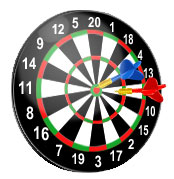
For example, when rolling a typical six-sided number cube, there is only one "6" on the cube and an equal chance of any number landing face up.

There are other types of probability. Sometimes, a simulation or a series of events has already occurred, and there is data that can be used to make a prediction. If you are estimating probability based on data that has been collected, it is called experimental probability.
For example, if a dart is randomly thrown at a dartboard 40 times, data can be collected based on the numbered sector in which the dart lands.
Dartboard Data |
|
Range of Numbers |
Number of Dart Landing |
1 - 5 |
11 |
6 - 10 |
9 |
11 - 15 |
8 |
16 - 20 |
12 |
Working with both theoretical and experimental probability is important, since frequently in the real world, what should happen, and what really does happen, are quite different!